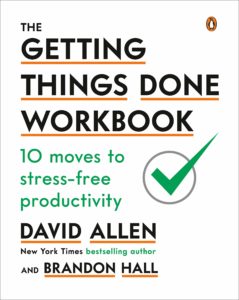 I was telling a friend about how amazing I thought The Four Hour Work Week was and how it changed my life to a friend one day, and offered to lend it to him. “OK”, he said, “and I will lend you Getting Things Done by David Allen”, his favourite book on personal productivity. I didn’t realise it when I started reading it, but GTD, as it’s known to lifehacks, was to change the way I looked at stacks of paper forever.
I was telling a friend about how amazing I thought The Four Hour Work Week was and how it changed my life to a friend one day, and offered to lend it to him. “OK”, he said, “and I will lend you Getting Things Done by David Allen”, his favourite book on personal productivity. I didn’t realise it when I started reading it, but GTD, as it’s known to lifehacks, was to change the way I looked at stacks of paper forever.
The Getting Things Done (GTD) system is a productivity methodology that aims to help individuals manage their work and personal life in a more efficient and organised way. The central idea behind GTD is to reduce stress and increase productivity by capturing all the information and ideas that come to mind, processing them, and organizing them in a systematic and reliable manner.
The GTD system is built on five core stages: capture, clarify, organise, reflect, and engage. At the capture stage, one is encouraged to collect all the ideas, tasks, and commitments that come to mind, irrespective of their size or complexity. These ideas and commitments are then processed, where one evaluates and decides what to do with them. The organise stage is where one sorts the commitments into categories and determines the priority level of each commitment. The reflect stage involves reviewing all commitments regularly, while the engage stage involves taking action on the commitments based on their priority level.
The main thrust of GTD is that people don’t organise their lives properly. They create massive stacks of paper in their in-trays and sift through it occasionally for anything they want to deal with at that moment. This makes for a dreadful productivity rate. David Allen’s solution is to have several different stacks, one for “processing” and piles for stuff that needs doing, stuff that needs filing, and stuff that you might want in the future but not right now.
It obviously gets a lot more complicated than that, but you get the general idea. David Allen also make the point that whatever system of organisation you use, you should apply to everything. Not just work, but your personal life, your email account, your relationship, everything. Allen says that much of the reason we can’t think clearly is because everything is half-processed in our heads, buzzing around and annoying us while we’re trying to concentrate on other things. In GTD, you take that thought, you add it to the “processing” stack, and then you forget about it until it’s time to go through the stack and process everything. Sorted.
The GTD system emphasizes the importance of capturing all the commitments that come to mind, whether they are work-related, personal, or otherwise. This is achieved through the creation of an “inbox” or collection tool, where all commitments are captured and processed regularly. This ensures that nothing is missed or forgotten, and that all commitments are dealt with efficiently.
There are some things I believe you have to abandon. One of the more complicated features of the GTD system is the tickler file. The tickler file is a system of folders that corresponds to each day of the month and twelve months of the year. The purpose is to remind individuals of tasks or commitments that are due on a specific day or month. GTD was written before the internet really going with productivity tools, so in the book, Allen describes a literal file you keep physical papers in. While the tickler file may be useful for some individuals, it can be unnecessarily complicated for others and may not be necessary for effective productivity. Though if you are that person, most productivity tools now have a “snooze” function that acts in a similar way.
And it works. On reading GTD, the first I did was to create a task-list of everything I wanted to do, in my work, my studies, my hobbies and personal time. It reached, once I was finally done, over 100 different items, all things that had been floating around in my head and not getting very far. I then went through my email inbox, archiving, deleting, noting things I should have replied to and never did, etc. I ended up with 30 emails left out of 1600, all of which went into the task list. Suddenly, with all these tasks in front of me that I could look at any time I finished what I was doing was the spur I needed – I now generate the same volume of ideas and email, but my tasklist has stayed relatively constantly at 30 tasks since I started, and I feel so much more productive.
If you are messy, chaotic and disorganised, this book will change your life. Read it.